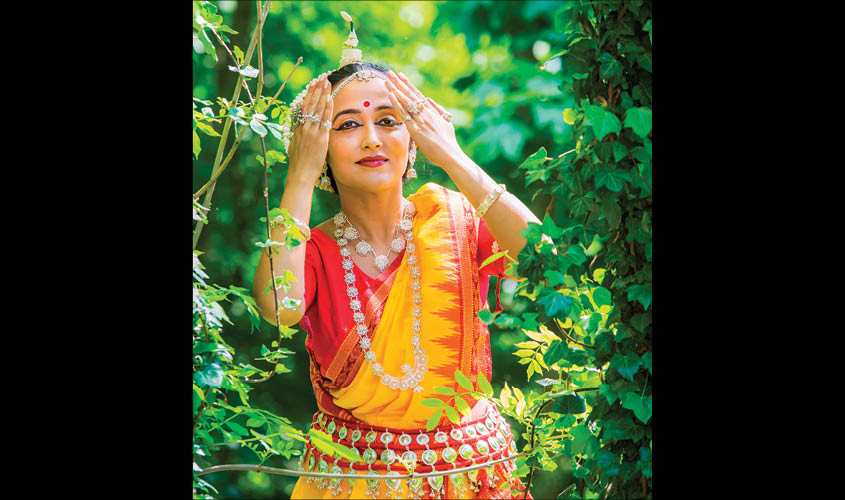I live in a world rushed by to-do lists and electronic devices. Stress is always waiting around the corner, like a demon waiting to cast its spell. Before he wreaks any havoc, I find my guardian angel, Odissi. Odissi is a beautiful dance form, brimming with creative and spiritual energies. But it is not just a dance form. She is the monsoon shower that banishes my dry spells of life, she is like the champa tree that shows me how nature regenerates, and she reinforces in my life the beauty of rhythm, rasa and time.
For my beautiful spiritual path of Odissi, I found my Guru Pratibha Jena Singh and the dance style of Guru Surendra Nath Jena. After nearly two decades of immersion, I learnt that dance teaches us daily abhyaas and not the other way round. Abhyaas is this powerful integration of the body, mind and spirit that is the best gift of the Indian arts. Kala, or art, like yoga and meditation, in Indian music and dance is a means for “union” with our deepest selves. And swayam khoj or the inquiry into the self, is what many artistes, sages and rishis have sought to investigate.
Like the scientists of today investigating the outer world, artistes in the Indian tradition have a powerful tool to access their inner world and its connection with the entire universe.
As I found my inner awareness growing with dance, it blossomed in the form of poetry. Curiously enough, I wrote poetry as a child, but never again after my teenage years. I chose to paint and then to dance. It was the Odissi dances of my guru’s tradition that brought me to appreciate the poetic view of life. The poetic view is a slanting view of life that is not frontal and focused. It is a powerful experience of insight and conversation with the inanimate. My love of Odissi gave birth to the dance-poems. Like mother and daughter, dance and poetry contain seeds of each other, so similar, yet so different in their character. The dance-poems flowed out of me in bursts, like powerful visions and conversations. I learnt to respect them, and when I began to dance them on stage, I knew it was time to share them as a book.
The Poetic Saree is a visualisation of dance-poetry as akin to a silk saree, rich and sumptuous to experience and multi-sensory in its fragrance. The dance-poems of this book explore the moods and themes of Indian art, the delights of nature and the landscapes of the heart. With exquisite dance visuals, The Poetic Saree uniquely unravels Indian aesthetics and spirituality through English poetry. But naturally, these dance-poems are fascinatingly visual, and they are taking a new form in dance. As I weave some poems from this book into a dance production, I feel like a garland-maker outside south Indian temples, making a garland of the divine, for the divine. Which flower-poems do I choose, or do they choose me in order to manifest?
Of the many dance-poems from the book, “The Poetry River” is the beginning of the book and the dances, illustrating the riverine, flowing nature of poetry, its nature element. While poetry flows like a saree, it brings us to the celebration of the unique Indian garment in “Saree and Me”. The saree becomes a fragrant, festive celebration of all the joy in the heart, a piece of art made by hand with love and care. It is this human connection that creates the saree magic that the poem and its dance celebrates. The saree connection continues in another poem, “Grandma’s Yellow”, where my grandmother’s yellow saree inspires me to dance “The Hanuman Chalisa” in Odissi, and admire my life as a homemaker with equal joy.
A chance visit to the boulders of Hampi left me struck with these monuments of history. They seemed to be in deep conversation with me, and by the next day, the poem “The Boulder Being” came out of me. Today this is the centrepiece of my dance production, as I find myriad associations with the boulder being within us, and its counterpart in nature. Other dance-poems like “Time to Return” and “Return” take the shape of the innerscape of the womb, where I return to the goddess as embryo, asking of my doubts and questions. My senses heighten, and this life-journey is visible more clearly with its “unlocked locks” that become a philosophy, my “garland of lights”. The many shades of this life-painting, become in Indian dance and music a source of great beauty and inspiration, and their ultimate aim is inner peace and harmony. What the world is searching for is available to us through our classical arts, and The Poetic Saree rejoices in this celebration.
The author is an Odissi dancer and poet

